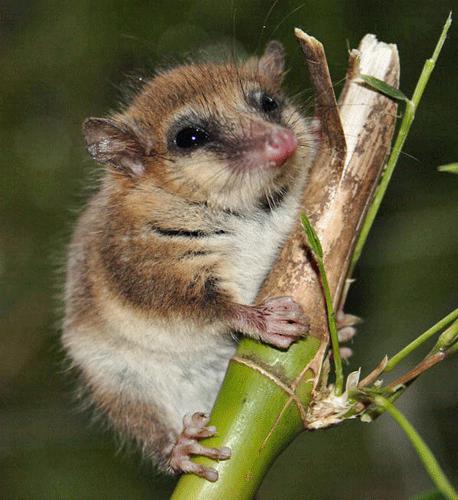Agustin Vitali
One of the greatest challenges in contemporary ecology is to understand how the homogenization of biodiversity at all levels of organization and spatial scales will influence the assembly of communities and the functioning of ecosystems. Such homogenization can occur through the gain of non-native species and the loss of native species. The main objective of this project is to evaluate how the gain of non-native ungulates and the loss of native species lead to a cascade of local extinctions in Patagonia. The results of this project will assist the Administration of National Parks in Argentina in the development of policy related to management the direct and indirect impacts of non-native species.

Dromiciops gliroides, a seed disperser marsupial of the Patagonia Temperate Forest. ©Mariano Rodriguez-Cabal.
The consequences of habitat disturbance, invasive alien species and global warming on biodiversity might be significantly underestimated when focusing on the impacts on one or a few species. Species interactions, both direct and indirect, are the main drivers of community assembly. Plant-animal mutualisms are essential for the maintenance of biodiversity and ecosystem integrity. The disruption of these interactions could cascade through the native community increasing extinction rates of species. However, most studies on the impact of global change largely ignore species interactions, especially indirect interactions. In many cases, indirect interactions can have greater impacts on community structure than direct interactions.
In Patagonia forest, the invasion of non-native ungulates affect directly plant communities through browsing, grazing and trampling, and indirectly by disrupting interactions with pollinators and seed dispersers. In the northern portion of this temperate forest there is a keystone interaction involving a hummingbird (Sephanoides sephaniodes), a mistletoe (Tristerix corymbosus), a dominant understory shrub and mistletoe host (maqui, Aristotelia chilensis), and an endemic marsupial (Dromiciops gliroides). This southern-most hummingbird relies on mistletoe nectar to survive the Patagonian winter. During the Patagonian spring the hummingbird pollinates approximately 20% of the woody plant genera in the Patagonian forests. The endemic and nocturnal marsupial is the only seed disperser of mistletoe in these forests; mistletoe seeds have to pass though the marsupial’s gut to germinate. This marsupial also disperses seeds of at least other 16 fleshy-fruited species. The mistletoe depends on the maqui as its principal host. Given such dependency, if non-native ungulates reduce the density of maqui, this could drastically reduce the abundance of the mistletoe and potentially disrupt this keystone mutualism. The main objective of this project is to evaluate how the addition of non-native ungulates and the resulting loss of native species lead to the disassembly of an interaction web in Patagonia resulting in a cascade of local extinctions. Specifically, this project will evaluate the consequences non-native ungulates on: plant community, pollination webs and seed dispersal web. The results of this project will provide critical insights into the indirect impact of non-native species, a commonly neglected concept in biological invasion. I believe that the results of this study will demonstrate the harm to mutualisms caused by non-native species and to develop management plans and policies that can be incorporated into real actions of conservation.